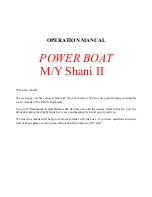
SAFE BOATING TIPS
PAGE
15
DOCKING
Docking your boat should be handled
carefully to avoid potential damage.
Under normal wind and water
conditions, the following considerations
should be made:
1. Whenever possible, your approach
should be made against the prevailing
wind and current to assist in stopping
the boat. Where these conditions are
contrary, the strongest should be used
to determine approach.
2. Approaching the dock: dock lines
should be at ready, loose gear stowed
and decks cleared. Determine the
direction of the wind and current and
when you decide which side of the boat
will be against the dock, rig dock lines
and fenders on the appropriate side.
One dock line should be attached to the
bow cleat, another to the stern cleat
opposite the side that will lie against the
dock.
NOTE: If the boat is to lie against
a piling, rig a fender board across two or
more pilings.
3. Tying up: attach bow and stern lines
to dock, hauling boat in with fenders
against dock. Rig crossing spring lines
to limit motion forward and aft. Be sure
to allow some slack in all lines to
compensate for tidal activity if present.
Never use bow rail, stern rail, or
stanchions to secure a vessel, even for
brief periods. For other types of
moorings, or for abnormal wind or water
conditions, consult an approved boating
guide.
ANCHORING
Your Hunter comes with an on deck
anchor well and a Danforth type anchor
as standard equipment. The anchor is
selected to suit the size and weight of
your boat under normal anchoring
conditions, and is most effective in
muddy or sandy bottoms.
When anchoring, pay particular attention
to the scope of your anchor rode (the
relationship between of the water and
the length of the rode). A good rule of
thumb is to allow a scope of about 7:1 (a
rode seven times as long as the vertical
distance from the bow to the bottom). A
helpful aid is to mark the rode every 20
feet or so with knots or other types of
indicators. Before dropping anchor,
make sure the bitter end is secured to
the cleat in the anchor well. Also, be
sure to consider wind direction, currents,
mean low tide depths and other local
conditions when anchoring, as well as
positions of any boats already anchored
nearby.
To weigh anchor, motor or sail (under
main only) forward slowly. When at a
point directly above the anchor, a quick
tug should free it from the bottom. Take
care not to damage the topsides when
hauling.
Anchoring in unusual water/ and or
weather conditions will require additional
precautions. Consult an approved guide
for suggestions
Summary of Contents for H356
Page 28: ......
Page 39: ......
Page 40: ......
Page 42: ......
Page 44: ......
Page 45: ......
Page 46: ......
Page 47: ......
Page 48: ......
Page 49: ......
Page 50: ......
Page 51: ......
Page 52: ......
Page 53: ......
Page 54: ......
Page 55: ......
Page 56: ......
Page 57: ......
Page 58: ......
Page 59: ......
Page 60: ......
Page 61: ......
Page 65: ......
Page 66: ......
Page 67: ......
Page 68: ......
Page 69: ......
Page 72: ......
Page 75: ......
Page 76: ......
Page 77: ......
Page 78: ......
Page 79: ......
Page 80: ......
Page 81: ......
Page 82: ......
Page 83: ......
Page 84: ......
Page 85: ......
Page 86: ......
Page 87: ......
Page 88: ......
Page 89: ......
Page 90: ......
Page 91: ......
Page 92: ......
Page 93: ......
Page 94: ......
Page 95: ......
Page 99: ......
Page 100: ......
Page 103: ......
Page 108: ......
Page 109: ......
Page 111: ......
Page 112: ......
Page 113: ......
Page 114: ......
Page 115: ......
Page 116: ......
Page 117: ......
Page 118: ......
Page 119: ......
Page 120: ......
Page 121: ......
Page 122: ......
Page 123: ......
Page 124: ......
Page 125: ......
Page 126: ......
Page 127: ......
Page 128: ......
Page 129: ......
Page 130: ......
Page 131: ......
Page 132: ......
Page 133: ......
Page 134: ......
Page 135: ......
Page 136: ......
Page 137: ......
Page 138: ......
Page 141: ......
Page 142: ......
Page 143: ......
Page 144: ......
















































